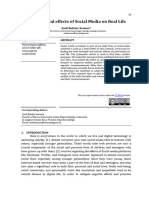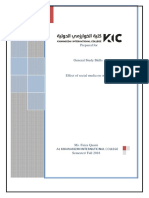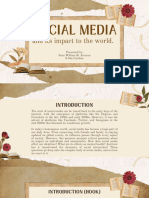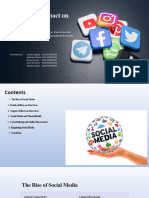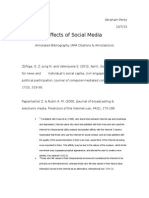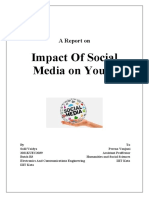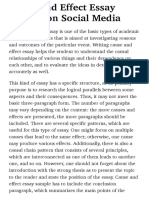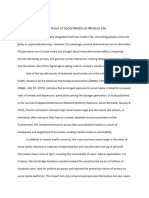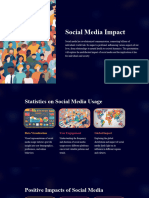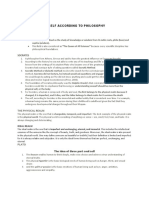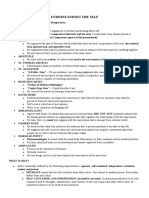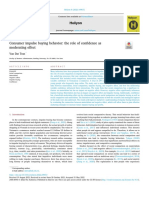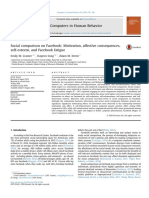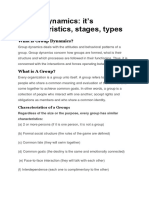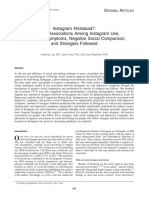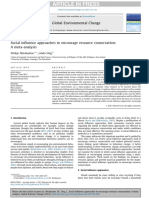Kross 2020
Uploaded by
Leonardo SchenckelKross 2020
Uploaded by
Leonardo SchenckelTICS 2101 No.
of Pages 12
Trends in
Cognitive Sciences OPEN ACCESS
Review
Social Media and Well-Being: Pitfalls, Progress,
and Next Steps
Ethan Kross,1,2,* Philippe Verduyn,3 Gal Sheppes,4 Cory K. Costello,1 John Jonides,1 and Oscar Ybarra1,2
Within a relatively short time span, social media have transformed the way humans Highlights
interact, leading many to wonder what, if any, implications this interactive revolu- Social media has revolutionized how
tion has had for people’s emotional lives. Over the past 15 years, an explosion humans interact, providing them with
unprecedented opportunities to satisfy
of research has examined this issue, generating countless studies and heated
their social needs.
debate. Although early research generated inconclusive findings, several experi-
ments have revealed small negative effects of social media use on well-being. An explosion of research has examined
These results mask, however, a deeper set of complexities. Accumulating whether social media impacts well-
being. First- and second-generation
evidence indicates that social media can enhance or diminish well-being depending studies examining this issue yielded
on how people use them. Future research is needed to model these complexities inconsistent results.
using stronger methods to advance knowledge in this domain.
An emerging set of third-generation
experiments has begun to reveal small
but significant negative effects of overall
The Puzzle: Does Social Media Impact Well-Being? social media use on well-being.
Humanity had flirted with the idea of building a machine capable of spreading ideas quickly
The results of these experiments mask
throughout the world for over 2000 years before all of the pieces necessary to do so finally came
the complexities characterizing the rela-
together for Johannes Gutenberg in the mid-1400s, while he was working on the shores of the Ill tionship between social media and well-
River in Strasburg [1]. It rested largely on Gutenberg’s invention of a technique for pressing being. Whether it enhances or diminishes
movable type (think of a scrabble set made of metal) against paper and ink to create a printed well-being depends on how and why
people use it, as well as who uses it.
page [1] (https://www.britannica.com/biography/Johannes-Gutenberg). Prior to Gutenberg’s
invention, it would take up to 2 months to produce a single copy of a book. Now printers People use social media for different
could produce 8000 copies during the same time [1]. reasons (e.g., to manage impressions,
to share emotions), which influence
how it impacts their own and other
The effect that the printing press had on society over the next 100 years was transformative. Suddenly people’s well-being.
people could read each other’s ideas, transmit new concepts, and respond to what others
were thinking. The printing press would help scientists and innovators disseminate their discoveries,
acting as a major force that propelled the Enlightenment [1] (https://www.history.com/news/
printing-press-renaissance). However, the printing press also ushered in negative outcomes. The
democratization of ideas meant that any idea could proliferate, including those that fomented
hate and fear. For example, the Protestant Reformation, a particularly violent period in European
history, was driven by the ease with which Martin Luther could spread beliefs that at the time 1
Department of Psychology, University
were viewed as heretical (https://www.history.com/news/printing-press-renaissance). of Michigan, Ann Arbor, MI, USA
2
Ross School of Business, University of
Michigan, Ann Arbor, MI, USA
Looking back at it now from the vantage point of the 21st century, the invention of the printing press 3
Faculty of Psychology and
provides an apt analogy for the world in which we are now living [2] (https://www.theatlantic.com/ Neuroscience, Maastricht University,
Maastricht, The Netherlands
magazine/archive/2020/01/before-zuckerberg-gutenberg/603034/). In the early 2000s, social 4
School of Psychological Sciences, Tel
media (see Glossary) proliferated and revolutionized the way the world communicates once Aviv University, Tel Aviv, Israel
again [3]. Close to 4 billion people use Facebook, Instagram, or Twitter, three of the most popular
social media platforms, to share and consume information (https://www.statista.com/statistics/
272014/global-social-networks-ranked-by-number-of-users/). Given the transformational impact
that this technology has had on society, it is unsurprising that people the world over have become *Correspondence:
interested in understanding how these media influence their emotional lives. ekross@umich.edu (E. Kross).
Trends in Cognitive Sciences, Month 2020, Vol. xx, No. xx https://doi.org/10.1016/j.tics.2020.10.005 1
© 2020 The Authors. Published by Elsevier Ltd. This is an open access article under the CC BY-NC-ND license (http://creativecommons.org/licenses/by-nc-nd/4.0/).
Trends in Cognitive Sciences
Over the past 15 years, an explosion of research has addressed this issue. Yet, the results of this work Glossary
are far from straightforward. While some studies indicate that social media undermine well-being, Active social media usage: engaging
other studies suggest the opposite, or that social media have no implications for this facet of people’s in social media activities that facilitate
lives. These seemingly contradictory sets of findings have elicited heated debates among scientists, interactions with others (e.g., chatting, or
broadcasting information).
leaving many confused (e.g., [4–6]). With this broader context in mind, our goals in this review are
Bonding social capital: the resources
to synthesize what we have learned about the relationship between social media and well-being to we derive through the strong ties we
highlight future research directions that are essential to propel this work forward. maintain with members of close groups.
Bridging social capital: the resources
we derive through the weak ties we
To anticipate our conclusion, our analysis suggests that, like the printing press, there is nothing maintain with people outside our close
inherently ‘good’ or ‘bad’ about social media. Whether they help or harm well-being depends groups.
on how and why people use them, along with who uses them (Figure 1, Key Figure). Before Cross-sectional methods:
discussing the research that supports this view, however, we begin by discussing the ostensibly observational research that examines
the relationships between data collected
simple question that instigated much of the debate in the first place: does the overall amount of at the same time point.
time that people spend on social media influence their well-being? Cyberbullying: use of electronic media
to perform intentional, aggressive acts
against others who cannot easily defend
The Search for Aggregate Effects
themselves.
Research examining the links between social media use and well-being began to proliferate in the Emotional support: expressions of
mid-2000s. Most of these early papers focused on Facebook, and that remains true to date [7–9]. care and concern.
Experience sampling: a longitudinal
method that involves measuring
Key Figure
people’s behavior and/or psychological
How Does Social Media Impact Well-Being? states multiple times per day, often over
the course of several days.
Fear of missing out (FOMO):
describes the fear of missing out on
important events, a negative
psychological state that propels
compulsive social media use and
promotes stress, negative affect, and
fatigue.
Informational support: provisions of
advice.
Jingle-jangle problem: a situation in
which different terms are used to refer to
the same process (e.g., using ‘social
media’, ‘online social networks’, and
‘digital screen time’ interchangeably,
using both ‘depression’ and ‘life
satisfaction’ to refer to well-being) and
the same terms are used to refer to
different processes (e.g., using social
media to refer to Facebook, Instagram,
and LinkedIn).
Longitudinal design: a design method
that involves collecting multiple
measurements on the same individual
Trends in Cognitive Sciences over time.
Meta-analysis: a statistical method
Figure 1. The image on the left indicates that there are many social media platforms, and new ones (reflected by the question that aggregates effect sizes across
marks) are constantly developing. To understand how these platforms impact well-being, research needs to explicate the multiple studies to enhance the power of
processes they activate, a sample of which are highlighted in the center image, with plus and minus signs connoting the detecting a significant effect.
fact that the same process may have positive and negative effects on well-being depending on the context in which they Moral outrage: the anger and shock
are engaged (see main text for discussion). The different numbers of positive and negative signs associated with each people experience in response to a
process highlight the fact that heterogeneity also exists in the degree to which different processes may impact well-being. perceived moral violation.
These processes may interact with each other, as well as individual and cultural differences, to influence well-being. The Passive social media usage:
image on the right illustrates the fact that researchers frequently use the term ‘well-being’ to refer to different constructs. A monitoring information on social media
key challenge for future research is to more precisely characterize how (i) different social media platforms (ii) impact without engaging in direct exchanges
different psychological processes, which in turn (iii) influence different facets of well-being. with others.
2 Trends in Cognitive Sciences, Month 2020, Vol. xx, No. xx
Trends in Cognitive Sciences
OPEN ACCESS
That said, variability exists in terms of the social media platforms that have been researched, and Perceived social support: believing
that there are people you can turn to for
many studies lump together different platforms to draw general conclusions about social media’s support.
implications for well-being (Box 1). Thus, we cast our discussion here at the more general level Received social support: receiving
of ‘social media’. assistance from other people.
Social comparisons: the act of
comparing oneself to others.
The first crop of papers that emerged from this work used self-report, cross-sectional methods Social media: online platforms that
to examine the association between social media use and well-being. Indeed, a comprehensive re- allow people to create and share
view of the literature concerning Facebook that included all articles published between 2005 and information with others.
2011 did not reveal any research examining how social media use influenced well-being over Social media platform: the specific
type of online platform that allows people
time [10]. The results of these early cross-sectional studies were inconsistent (for reviews see to create and share information
[11,12]). While some revealed negative associations between social media use and well-being, (e.g., Facebook, Twitter).
others revealed positive links or results that were moderated by individual differences (e.g., online Trolling: deliberate posting of
inflammatory and divisive information to
social network size, depressive symptoms, gender, loneliness).
upset others.
Upward social comparisons:
These contradictory findings motivated a second generation of studies that began to appear in comparing yourself with someone who
the early 2010s, which used more sophisticated methods (e.g., experience sampling, large- is outperforming you (as opposed to a
downward social comparison, in which
scale longitudinal designs, advanced modeling techniques) to shed light on the puzzle that
you compare yourself with someone
had emerged. The outcomes of this work were, however, no more conclusive; they likewise who you are outperforming).
failed to generate a coherent pattern of results. Some studies linked aggregate social media Well-being: a concept that captures
use with declines in well-being over time [11,13–16], while other work revealed no substantive how happy people are (‘affective well-
being’) and how satisfied they are with
links (e.g., [17–22]) or relationships that were nonlinear or again moderated by individual dif- their lives (‘cognitive well-being’).
ferences [20,23–25]. Although these facets of well-being often
correlate, they capture distinct
It is not uncommon to see discrepant findings emerge in a growing literature, especially when it constructs. In the social media/well-
being literature, additional constructs are
deals with a multifaceted phenomenon such as social media usage. However, two features of often subsumed under the heading of
these second-generation studies make them challenging for drawing conclusions (Box 1). First, well-being, such as depression,
they are not consistent in how they operationalize and assess social media use or well-being; loneliness, anxiety, and FOMO.
while some studies examine the impact of short bursts of specific kinds of social media platform
usage on momentary affect over the course of minutes or hours, others focus on longer periods of
usage or collapse across multiple platforms and focus on other facets of well-being. Second,
Box 1. The Jingle-Jangle Problem
Research on social media brings together scientists from many backgrounds. The interdisciplinary nature of this enterprise is
an asset: diversity breeds innovation [105]. However, one unintended byproduct of this amalgamation of perspectives is that
we are now faced with what psychologists and philosophers refer to as a jingle-jangle problem [106,107]: a situation in
which different terms are used to refer to the same process (e.g., using ‘social media’, ‘online social networks’, and ‘digital
screen time’ interchangeably) and the same terms are used refer to different processes (e.g., using social media to refer to
Facebook, Instagram, and LinkedIn, using well-being to refer to depression and life satisfaction).
Jingle-jangle fallacies are endemic to many areas of science. On the one hand, they are characteristic of flourishing areas
of work that bring together researchers from different backgrounds. On the other hand, they can pose a major obstacle
to building integrative and appropriately nuanced models of psychological phenomena. To illustrate, consider the case
of different research groups using the same term ‘social media’ to refer to different platforms such as Facebook or Twitter.
Facebook and Twitter share many features, but they differ notably in structure and usage norms as well. Whether the
differences that distinguish them are relevant for people’s well-being is a question for scientists to answer, but referring
to these platforms with the same label can lead us to gloss over potentially meaningful distinctions [9] (see Figure 1 in main
text). The same is true for well-being. Although depression and life satisfaction are both related to well-being, substantive
differences distinguish these constructs [50].
Researchers have made admirable attempts to address social media’s jingle-jangle problem over the years [7,108], but a
close reading of the literature indicates that it persists [109]. Moving forward, a key challenge is for scientists to agree on a
common lexicon that captures the full range of variables that are relevant to the study of social media and well-being.
Trends in Cognitive Sciences, Month 2020, Vol. xx, No. xx 3
Trends in Cognitive Sciences
recent findings indicate that the self-report measures of social media usage that many of these
studies use have questionable validity. One study of approximately 50 000 people from 15 coun-
tries found, for example, that ten popular survey measures of people’s Facebook behavior corre-
lated only weakly (r between 0.23 and 0.42) with people’s actual Facebook usage [26].
A major leap forward occurred in the mid-2010s, when experiments, the gold-standard tool for
drawing causal inferences, began to examine the effect of manipulating aggregate social media
usage on well-being. Although the total number of such studies remains small and there are
caveats associated with them (i.e., they vary in how they manipulate social media use, do not con-
sistently focus or document effects on the same measures, and rely on convenience samples where
self-selection biases are a concern), a set of results linking social media use with small but significant
declines in well-being has begun to emerge. For example, of the eight aggregate usage experi-
ments described in one exhaustive open-source review compiled by scholars on both sides of
the social media/well-being debate (J. Haidt and J. Twenge, unpublished), six revealed a negative
effect of aggregate social media use on some [27–29] or all [30–32] of the well-being measures
they administered (although 37’s effects were specific to Instagram, not Facebook). By contrast,
one experiment revealed mixed positive and negative results [33] and another null [34] findings.
So, Where Does this Leave Us?
Although many experts increasingly acknowledge that small negative effects characterize how
aggregate social media use impacts well-being (Box 2), some argue that the size of these effects
are so small that they have no practical significance [35]. Others have called for methodological
reform, highlighting the need for future research to use stronger designs and more valid measures
[35,36]. The first of these positions is defensible and we strongly agree with the second. However,
in our view, both fail to address an equally important – and arguably deeper – psychological issue.
Namely, that the story surrounding social media’s impact on well-being is much more
nuanced than these aggregate studies suggest and by restricting our focus to overall usage,
Box 2. Meta-Analyses
Meta-analyses are statistical tools that aggregate effect sizes across studies to increase the power needed to detect
significant effects. Researchers have increasingly turned to them to sort through the conflicting findings that characterize
the literature on social media and well-being.
Across meta-analyses published to date, researchers have documented a statistically significant negative association
between social media usage and well-being [77,110–112], a finding that is consistent with the experimental work reviewed
in the text as well as several recent systematic reviews of the literature [4,6,35]. The size of this meta-analytic effect is small.
One review estimated that overall social media use explains 1% of the variance in well-being [6]. However, the results of
two recently published meta-analyses add important nuance to this finding.
Liu and colleagues [70] found, for example, that using social media to interact with others was associated with improved
psychological well-being whereas passive consumption of information on social media was linked with reduced well-be-
ing. The size of these meta-analytic effects were roughly twice as large as the overall effect of social media use on
wellbeing. An additional meta-analysis that focused on depression and social media usage [112] revealed a similar set
of findings. Using social media to engage in harmful social comparisons was linked more strongly with depression than
overall social media usage.
Overall, the results of these meta-analyses are consistent with the idea that a small relationship characterizes the effect of
social media on well-being. They also reinforce the value of distinguishing between different facets of social media usage to
understand how this technology impacts well-being. There are, however, two important caveats when considering how
these meta-analytic results factor into the emerging knowledge base on social media and well-being. First, meta-analyses
are only as informative as the studies that comprise them. If a meta-analysis includes a disproportionate number of studies
characterized by weak or problematic methods, their results should be appropriately qualified. Although it is possible to
take study quality into account when performing meta-analyses, this is not always done. Second, meta-analyses often
collapse across measures that are conceptually related but distinct (e.g., general mood vs depression, social media usage
over the course of minutes vs days). This can lead one to gloss over distinctions that are, in some cases, meaningful.
4 Trends in Cognitive Sciences, Month 2020, Vol. xx, No. xx
Trends in Cognitive Sciences
OPEN ACCESS
we risk losing sight of how this technology can modulate well-being for better or worse, and we
lose the opportunity to develop a fine-grained understanding of the psychological mechanisms that
govern how it operates.
From ‘Does’ to ‘How’: A Process Perspective
In this section, we review research that illustrates how considering the psychological processes
that drive people’s social media behavior can help explain when using this technology leads to
well-being improvements or declines. Our goal in focusing on the two processes we discuss –
self-presentation and sharing emotions – is not to be exhaustive of the different reasons why
people use social media or the myriad ways that it can influence well-being. Rather, it is to dem-
onstrate the value of moving past asking questions about aggregate social media usage. In this
vein, we focus on two sets of psychological processes that decades of research indicate are
foundational to how people function, which have been extensively studied in a social media
context.
Self-Presentation
In 1956, Erving Goffman published a landmark book titled The Presentation of Self in Everyday
Life [37]. It argued that life is like a dramatic performance. The stage we act on is life, and we
assume different roles when we interact with different people with a particular goal in mind: to
manage how they perceive us. According to Goffman, we are never free of this built-in human
theater. We are acting all the time.
A great deal of research and theory supports Goffman’s thesis: we spend much of our time trying
to manage what others think of us [38,39]. There are, however, limits to the degree that we can
engage in this process offline. We can do our best to primp and prep before a job interview in our
homes, but ultimately we have limited control over what happens when we leave. Countless
unpredictable obstacles can get in the way of presenting our best selves when we navigate the
world offline.
Social media, by contrast, provide us with new opportunities to curate the way we present our-
selves [40–42]. We can post our most glamorous photographs and upload our wittiest posts.
Managing how we present ourselves in this way can have positive consequences [43]. Experi-
ments show that asking people to view their social media profile increases their self-esteem
[44,45] and their ability to manage negative feedback [46]. Some evidence suggests that people
are, at some level, aware of these benefits. For example, one experiment found that people
spontaneously viewed their own profile after receiving rejection feedback, presumably to improve
their mood [46]. But curating the way we present ourselves on social media can also have
unintended negative consequences: it can lead us to feel worse when we compare our own
lives against those we see depicted on social media (for a review see [47]).
Social comparisons are a cross-cultural phenomenon that emerge in early childhood and have
deep evolutionary roots [48,49]. We engage in them because they provide us with often useful
information regarding how we stack up against our peers. However, when we compare ourselves
to people on social media who are outperforming us (i.e., an upward social comparison), we
end up feeling envy and distress (e.g., [50–59]). Emerging evidence has also begun to link upward
social comparisons on social media with the experience of fear of missing out (FOMO) [60],
meaninglessness [61], and body-image dissatisfaction [55,62].
To put the magnitude of this issue in perspective, consider one study that asked 37 729 partici-
pants from 18 different countries to indicate whether they had compared themselves with others
Trends in Cognitive Sciences, Month 2020, Vol. xx, No. xx 5
Trends in Cognitive Sciences
on Facebook over the past 2 weeks in a way that made them feel badly [63]. Approximately 8500
participants – 22.5% of the sample – answered affirmatively. Moreover, of those participants who
reported engaging in social comparisons, approximately one-third indicated that their negative
feelings persisted for 1 day or more (also see [64]). If you think about these results in terms of
the close to 3 billion people who use Facebook, they raise the possibility that a substantial portion
of people may be negatively impacted by engaging in social comparisons (i.e., approximately
675 million if you generalize from these results).
There are caveats. Certain kinds of upward social comparisons are more harmful than others
(e.g., focusing on others’ abilities vs opinions [65]). Moreover, as the heterogeneity of the effect
characterizing the large, multicountry study of social comparisons that we just described sug-
gests (roughly three-quarters of the sample did not compare themselves with others in a way
that made them feel bad), some people are more vulnerable to the negative effects of social
media comparison then others (i.e., people who are depressed or overly prone to engaging in so-
cial comparisons [64,66–69]). These exceptions notwithstanding, converging evidence highlights
how engaging in social comparisons on social media undermines well-being [70].
To the degree that people spend more time on social media voyeuristically consuming informa-
tion about others than viewing their own profiles [43,50,71] and are more sensitive to negative
than positive experiences [72,73], this could explain why the overall effects of social media
usage on well-being tilt slightly in the negative direction. More broadly, this literature demonstrates
how the human drive to manage impressions plays out on social media in complicated ways,
some of which can have beneficial consequences for the self but negative implications for others.
Sharing Emotions
Decades of research indicate that when we experience strong positive and negative emotions,
we are intensely motivated to share them [74]. According to Rime’s Social Sharing Theory of
Emotions, doing so helps us pursue two goals: the satisfaction of our socioemotional needs,
which involves obtaining support from others to help us validate our feelings, normalize our expe-
riences, and savor positive states, and our cognitive needs, which involve receiving advice from
others to help us make sense of our experiences.
Social media provide people with unprecedented opportunities to pursue these goals [75,76]
by allowing us to instantly connect with people we are close to (i.e., bonding social capital)
and more distantly acquainted (i.e., bridging social capital) [77]. Indeed, a wide range of
studies indicate that social media provide feedback that satisfies people’s socioemotional
(i.e., ‘emotional support’) and cognitive (i.e., ‘informational support’) needs and enhances
their levels of perceived and received social support (for reviews see [6,78,79]). In some
cases, the support benefits that people derive from social media outweigh those they obtain in
the offline world. For example, one pair of studies found that people with depression, who tend
to receive less support then their non-depressed counterparts offline [80], received more support
on social media [81].
As with research on social comparisons, there are caveats associated with these findings. For
example, the more one interacts with members of one’s network and the faster one receives
responses from them, the higher their perceptions of support [82]. Moreover, for reasons that
are not yet clear, males, Euro-Americans, and younger students tend to benefit less from social
media support then females, Asians, and older students [78]. Nevertheless, extant research sup-
ports the idea that social media bolster people’s actual and perceived support, variables that are
centrally relevant to well-being [83,84].
6 Trends in Cognitive Sciences, Month 2020, Vol. xx, No. xx
Trends in Cognitive Sciences
OPEN ACCESS
But just as social media provide us with new opportunities to seek and provide support, they
also allow us to share our feelings in ways that hurt others. In this vein, a large literature
shows that social media provide people with platforms for cyberbullying and trolling,
moderately prevalent (range: 10–40% [85,86]) antisocial behaviors that negatively impact
others’ well-being (e.g., [87–89]). Although individual differences play a role in determining
who engages in these acts [85,90], certain features of social media promote them. For
example, social media strip away cues that activate empathic responses during face-to-face
interactions, which constrain aggressive behavior (e.g., [91–95]). They also make it easier for
people to share their emotions when they peak and are most motivated to do so [96,97].
Social media also plays a role in spreading moral outrage [97–99], which contributes to the
dehumanization of others [100] and may reduce collective action [101] and deepen social divides
[97]. Emerging evidence suggests that social media are particularly adept at spreading indigna-
tion. For example, one experience-sampling study found that people were more likely to both
come in contact with and respond intensely to declarations of moral outrage online (likely includ-
ing social media) versus offline [102].
Taken together, these findings demonstrate that social media provide us with a new platform to
satisfy our desire to share emotions with others. In some cases, these divulgences are linked with
positive well-being outcomes, providing new opportunities for people to obtain social support.
However, they can also promote negative outcomes by providing a platform for cyberbullying,
trolling, and spreading hate.
Moving Forward
We have drawn multiple parallels between the printing press and social media in this review, but
there is one notable difference. Whereas the printing press took decades to revolutionize the way
society functioned, social media have had a transformational impact in a tiny window of time.
Nevertheless, scientists have been remarkably nimble in their ability to reroute their research
programs to respond to the challenge of making sense of how this technology impacts people’s
emotional lives. Indeed, we view the past 15 years of research on social media and well-being as
a testament to scientists doing what they do best: focusing on important phenomena, critically
evaluating current knowledge in light of new results, and bringing to bear increasingly sophisti-
cated methods and conceptual frameworks to generate novel solutions that have important
basic science and practical implications. But where does all of this work leave us in terms of
the question on so many people’s minds: how do social media influence well-being?
Converging reviews of the literature suggest that a small but significant negative relationship charac-
terizes the effect of social media on well-being (Box 3). If this is all that one cares about, that is the
bird’s eye view. It would be a mistake, however, to conclude from these findings that social media
have little potential to influence people’s emotional lives. Our survey suggests that the situation
concerning social media’s impact on well-being is considerably more nuanced than aggregate
usage studies suggest. The effects of social media on well-being are not uniform. Social media
present people with a new ecosystem for engaging in social interactions, and converging evidence
indicates that how this ecosystem affects our well-being, and the well-being of others, depends on
how we navigate it.
If social media have both positive and negative implications for well-being, one question concerns
why the dominant narrative in the media has disproportionately focused on its dire consequences
[6]. The newsworthiness of such headlines is likely to play some role in explaining this phenomenon,
but we suspect it is not the only factor. In this vein, it is worth highlighting the fact that one of
Trends in Cognitive Sciences, Month 2020, Vol. xx, No. xx 7
Trends in Cognitive Sciences
Box 3. Beyond ‘Active’ versus ‘Passive’ Usage
In an attempt to integrate research showing that different ways of using social media differentially impact well-being, sev-
eral groups have distinguished between two general categories of social media usage: ‘active’ and ‘passive’ social me-
dia usage. According to this framework, the passive consumption of information on social media undermines well-being
by increasing upward social comparisons. Conversely, the active use of social media to exchange information and to con-
nect with others enhances well-being by enhancing social capital and support.
This framework has proved useful in pushing the field to think more mechanistically and has revealed differential negative
effects of passive (vs active) use (Box 2). Nevertheless, further refinement of this framework is necessary; current research
suggests that it is too coarse. As we discuss in the main text, although passively viewing other people’s social media
profiles reliably undermines well-being, passively viewing one’s own profile has the opposite effect. Likewise, although
actively using social media to garner support improves well-being, actively using it to cyberbully or spread moral outrage
undermines well-being for others. Thus, a key challenge is to move beyond this nominal distinction to examine subtypes of
active and passive social media use. In particular, two questions are pressing.
First, we need to understand how different motivations for using social media interact to influence well-being. Extant
research has primarily focused on how different social media motivations operate in isolation. However, human behavior
is multiply determined; multiple goals drive people’s behavior, which are activated to various degrees depending on
individual differences and the circumstances people find themselves in [113,114]. And in some cases, motivations conflict.
For example, a person may be driven to abstain from viewing others’ profiles to avoid feeling envy, but simultaneously
motivated to share their emotions with others. Which of these motivations is stronger may influence whether and how
people interact with social media and the implications that doing so has for their well-being.
Second, research is needed to examine whether people are aware of the implications that their social media behavior has
for themselves and others. Our review suggests that an asymmetry characterizes how several social media behaviors
impact the self versus others. For example, curating one’s profile improves how one feels, but promotes envy among
others; cyberbullying disproportionately impacts the targets (vs perpetrators) of such behavior. Whether people are aware
of these asymmetries is unknown, as are the consequences of informing them about them for regulating their social media
behavior.
psychology’s most foundational findings concerns our tendency to overweight negative (vs positive)
information [72,73]. Thus, it is possible that people form generalizations about social media’s over-
all well-being impact based on the negative effects they have in some situations (e.g., upward social
comparisons, cyberbullying). A key challenge moving forward is to identify how to disseminate
information about social media’s positive and negative implications without having the latter
obscure the former.
From a basic science perspective, future research is needed to move beyond asking broad
questions about the overall effects of social media on well-being (see Outstanding Questions).
Rather, the strategy now should be to study the different psychological processes that explain
how and why social media impact well-being differently, whether different social media behaviors
have downstream effects that extend beyond well-being (e.g., to impact family and school life),
and why these effects may vary for different people in different cultures guided by distinct social
norms. Although we focused on two candidate processes in this review that have been the focus
of extensive research, many other processes are waiting to be examined. Work should continue
to profile how target processes operate in isolation but also explore how they interact (Box 3).
Studies that seek to address the latter issue should also consider the unique information-
processing dynamics that may underlie different types of social media behaviors. Managing
one’s online persona would seem, for example, to be a reflective act that requires time and
deliberation to implement. Sharing emotions with others, by contrast, may be a more reflexively
driven behavior. Understanding the degree to which different social media behaviors are
reflexively versus reflectively driven has the potential to both illuminate the processes that underlie
them and inform the development of interventions designed to enhance social media’s impact on
well-being [102].
8 Trends in Cognitive Sciences, Month 2020, Vol. xx, No. xx
Trends in Cognitive Sciences
OPEN ACCESS
Focusing more on psychological processes also has the potential to provide insight into the Outstanding Questions
question of how different social media platforms uniquely impact well-being. By focusing on the Can we find a common lexicon to
processes that different platforms activate, as opposed to simply comparing Platform A conceptualize the social media
landscape? Addressing this issue is
(e.g., Facebook) versus Platform B (e.g., Instagram), we can move beyond the nominal distinc-
vital to solving social media’s jingle-
tions that distinguish platforms, to the more meaningful psychological variables that influence jangle problem (Box 1).
users’ experience (Figure 1).
Can we develop theory-driven frame-
works to identify candidate processes
This issue is also relevant to the emerging experimental literature examining the impact of manip-
that explain how social media impacts
ulating aggregate social media use on well-being. Extant research manipulates social media well-being and generate predictions
usage in a variety of ways. Some work contrasts experimentally induced abstention against reg- about how they operate in isolation
ular usage (e.g., [33]) while others contrast induced usage against an active or non-active control and interactively? Can such frame-
works be used to distinguish between
(e.g., [32]), and there is further heterogeneity within these broad approaches (e.g., in the length of different social media platforms?
abstention/usage, simple abstention vs deactivation of accounts). Each of these different manip-
ulations may activate a different set of underlying processes that have implications for people’s Can we make further distinctions
within active and passive social
well-being.
media usage? Do different active
and passive behaviors relate to
Studying psychological processes requires, however, that we utilize strong methods. The field’s different psychological processes?
overreliance on cross-sectional designs is a major weakness [35,36], yet cross-sectional Are some behaviors more impulsive
versus deliberate? How might these
research continues to proliferate. We urge researchers interested in exploring the social media–
different behaviors impact well-being?
well-being relationship to incorporate experimental and longitudinal designs into their work to
strengthen their ability to draw inferences about causality. Do asymmetries in the way certain
social media behaviors impact the self
versus others help to explain why
More work is also needed to validate the methodologies we use to study the impact of social some harmful practices persist? If so,
media on well-being. We have already discussed the validity concerns associated with commonly how can such information be utilized
used self-report Facebook usage variables. However, similar issues apply to other measures to inform interventions?
used in this area. For example, one prominent study counted the number of emotion words
Can we systematize the way we perform
contained in people’s Facebook posts to draw inferences about how they felt although no valida- experiments on social media? Some
tion data supported the use of such methods to track people’s emotions on social media [103]. experiments direct people to abstain
As later research pointed out, counting emotion words does not track how people feel on from using social media while others
direct them to use it more compared
Facebook [104]. The take-home point is simple: psychometrically sound measures are not a with baseline. Heterogeneity also
luxury: they are instrumental for valid inferences. characterizes the time course of
different manipulations, the measures
used to document their effects, and the
From a translational standpoint, there is a need to identify science-based interventions that
frequency of their administration. All of
enhance the positive and minimize the negative consequences of social media. There are at these factors could differentially impact
least three paths to studying these interventions (Figure 2). One involves directing people to study results depending on the nature
use social media in particular ways, and then gauging the implications of such person-focused of the process being manipulated.
interventions. Much of the existing experimental work in this area takes this form. A second How can we balance the need to
path involves examining how modifying the social media platforms that people use (with their perform studies quickly on an evolving
informed consent) impacts the way they use them and how they affect well-being. For example, technology without compromising
a platform could be augmented to promote the sharing of information that research suggests the need to use valid measures and
methods?
should enhance well-being. Finally, a third method involves a combination of the previous two
approaches; that is, simultaneously educating people about how to navigate social media opti- Can we design person- and platform-
mally and tweaking social media platforms to maximize their positive impact. centered interventions that amplify the
positive and diminish the negative impli-
cations of social media use on well-
Concluding Remarks being?
Social media, like the printing press, represent a kind of disruptive technology that appears once
in a generation. Over the past 15 years science has done an admirable job advancing our How can we disseminate information
about social media’s positive and
understanding of the impact these media have on our well-being, but the work is by no means negative impacts without having the
complete. Numerous questions remain. Given the energy and enthusiasm characterizing work latter obscure the former, given the
in this area, and the enormous level of talent working on solving these questions, we suspect
Trends in Cognitive Sciences, Month 2020, Vol. xx, No. xx 9
Trends in Cognitive Sciences
documented tendency for people
to overweight negative (vs positive)
information?
Trends in Cognitive Sciences
Figure 2. Social Media Intervention Research. At least three pathways exist for process-focused social media
intervention research. Person-centered interventions focus on changing how people use social media to enhance well-
being. Potential ways of communicating this information include instructing individuals directly, relaying information through
parents, teachers, or supervisors, and the creation of institutional policies. Platform-centered interventions involve
changing the way that social media platforms function (with user consent) to enhance their likelihood of promoting well-
being. Finally, the person + platform intervention pathway involves the examination of the effects of both kinds of
intervention simultaneously.
that the next 15 years will be ripe with discoveries that advance our understanding of how this
ubiquitous technology influences our emotional lives.
Acknowledgments
We thank Janet Kim and Susannah Cazaubon for their help preparing the manuscript, a grant from the John Templeton
Foundation to E.K., and a gift from Facebook to E.K. We are grateful to Jonathan Haidt and Jean Twenge for developing
an open-source Google document summarizing research on social media and well-being, which informed our literature
review. The review’s authors indicate that they have no affiliation or involvement in any organization or entity with any financial
interest in the subject matter or materials discussed in the manuscript other than the gift disclosed above.
References
1. Man, J. (2003) The Gutenberg Revolution: The Story of a Genius 14. Boers, E. et al. (2019) Association of screen time and depres-
and an Invention That Changed the World, Gardners Books sion in adolescence. JAMA Pediatr. 173, 853–859
2. Dewar, J.A. (1998) The Information Age and the Printing Press: 15. Kim, H.H.-S. (2017) The impact of online social networking on
Looking Backward to See Ahead, RAND Corporation adolescent psychological well-being (WB): a population-level
3. Boyd, D. and Ellison, N. (2007) Social network sites: definition, analysis of Korean school-aged children. Int. J. Adolesc.
history, and scholarship. J. Comput. Mediat. Commun. 13, Youth 22, 364–376
210–230 16. Viner, R.M. et al. (2019) Roles of cyberbullying, sleep, and
4. Orben, A. and Przybylski, A.K. (2020) Reply to: Underestimating physical activity in mediating the effects of social media
digital media harm. Nat. Hum. Behav. 4, 349–351 use on mental health and wellbeing among young people
5. Twenge, J.M. et al. (2020) Underestimating digital media harm. in England: a secondary analysis of longitudinal data. Lancet
Nat. Hum. Behav. 4, 346–348 Child Adolesc. Health 3, 685–696
6. Appel, M. et al. (2020) Are social media ruining our lives? A 17. Ferguson, C.J. et al. (2014) Concurrent and prospective
review of meta-analytic evidence. Rev. Gen. Psychol. 24, 60–74 analyses of peer, television and social media influences
7. Bayer, J.B. et al. (2020) Social media elements, ecologies, and on body dissatisfaction, eating disorder symptoms and
effects. Annu. Rev. Psychol. 71, 471–497 life satisfaction in adolescent girls. J. Youth Adolesc. 43,
8. Rains, S.A. and Brunner, S.R. (2014) What can we learn about 1–14
social network sites by studying Facebook? A call and recom- 18. Jensen, M. et al. (2019) Young adolescents’ digital
mendations for research on social network sites. New Media technology use and mental health symptoms: little evidence
Soc. 17, 114–131 of longitudinal or daily linkages. Clin. Psychol. Sci. 7,
9. Stoycheff, E. et al. (2017) What have we learned about social 1416–1433
media by studying Facebook? A decade in review. New 19. Coyne, S. et al. (2020) Does time spent using social media
Media Soc. 19, 968–980 impact mental health? An eight year longitudinal study.
10. Wilson, R.E. et al. (2012) A review of Facebook research in the Comput. Hum. Behav. 104, 106160
social sciences. Perspect. Psychol. Sci. 7, 203–220 20. Orben, A. et al. (2019) Social media’s enduring effect on
11. Kross, E. et al. (2013) Facebook use predicts declines in adolescent life satisfaction. Proc. Natl. Acad. Sci. U. S. A.
subjective well-being in young adults. PLoS One 8, e69841 116, 10226–10228
12. Verduyn, P. et al. (2017) Do social network sites enhance or 21. Heffer, T. et al. (2019) The longitudinal association between
undermine subjective well-being? A critical review. Soc. Issues social-media use and depressive symptoms among adolescents
Policy Rev. 11, 274–302 and young adults: an empirical reply to Twenge et al. (2018). Clin.
13. Shakya, H.B. and Christakis, N.A. (2017) Association of Psychol. Sci. 7, 462–470
Facebook use with compromised well-being: a longitudinal 22. Berryman, C. et al. (2018) Social media use and mental health
study. Am. J. Epidemiol. 185, 203–211 among young adults. Psychiatr. Q. 89, 307–314
10 Trends in Cognitive Sciences, Month 2020, Vol. xx, No. xx
Trends in Cognitive Sciences
OPEN ACCESS
23. Kelly, Y. et al. (2018) Social media use and adolescent 49. Gilbert, P. et al. (1995) Social comparison, social attractiveness
mental health: findings from the UK millennium cohort and evolution: how might they be related? New Ideas Psychol.
study. EClinicalMedicine 6, 59–68 13, 149–165
24. Twenge, J.M. and Campbell, W.K. (2019) Media use is linked 50. Verduyn, P. et al. (2015) Passive Facebook usage undermines
to lower psychological well-being: evidence from three affective well-being: experimental and longitudinal evidence.
datasets. Psychiatr. Q. 90, 311–331 J. Exp. Psychol. Gen. 144, 480–488
25. Przybylski, A.K. and Weinstein, N. (2017) A large-scale test of 51. Tandoc Jr., E.C. et al. (2015) Facebook use, envy, and depres-
the Goldilocks hypothesis: quantifying the relations between sion among college students: is Facebooking depressing?
digital-screen use and the mental well-being of adolescents. Comput. Hum. Behav. 43, 139–146
Psychol. Sci. 28, 204–215 52. Ozimek, P. and Bierhoff, H.-W. (2020) All my online-friends are
26. Ernala, S. et al. (2020) How well do people report time spent on better than me – three studies about ability-based comparative
Facebook? An evaluation of established survey questions with social media use, self-esteem, and depressive tendencies.
recommendations. In Computing Systems: Proceedings of the Behav. Inf. Technol. 39, 1110–1123
2020 CHI Conference on Human Factors, pp. 1–4, Association 53. Krasnova, H. et al. (2015) Research note – why following
for Computing Machinery friends can hurt you: an exploratory investigation of the effects
27. Allcott, H. et al. (2020) The welfare effects of social media. Am. of envy on social networking sites among college-age users.
Econ. Rev. 110, 629–676 Inf. Syst. Res. 26, 585–605
28. Hunt, M.G. et al. (2018) No more FOMO: limiting social media 54. Burnell, K. et al. (2019) Passive social networking site use and
decreases loneliness and depression. J. Soc. Clin. Psychol. well-being: the mediating roles of social comparison and the
37, 751–768 fear of missing out. Cyberpsychology (Brno) 13, 5
29. Mosquera, R. et al. (2020) The economic effects of Facebook. 55. Tiggemann, M. et al. (2018) The effect of Instagram “likes” on
Exp. Econ. 23, 575–602 women’s social comparison and body dissatisfaction. Body
30. Sagioglou, C. and Greitemeyer, T. (2014) Facebook’s emotional Image 26, 90–97
consequences: why Facebook causes a decrease in mood and 56. Hu, Y.-T. and Liu, Q.-Q. (2020) Passive social network site use
why people still use it. Comput. Hum. Behav. 35, 359–363 and adolescent materialism: upward social comparison as a
31. Tromholt, M. (2016) The Facebook experiment: quitting mediator. Soc. Behav. Pers. 48, e8833
Facebook leads to higher levels of well-being. Cyberpsychol. 57. Yuen, E.K. et al. (2019) The effects of Facebook on mood in
Behav. Soc. Netw. 19, 661–666 emerging adults. Psychol. Pop. Media Cult. 8, 198–206
32. Engeln, R. et al. (2020) Compared to Facebook, Instagram use 58. Albers, G. et al. (2019) Social media and depression symptoms:
causes more appearance comparison and lower body satis- a network perspective. J. Exp. Psychol. Gen. 148, 1454–1462
faction in college women. Body Image 34, 38–45 59. Lin, R. and Utz, S. (2015) The emotional responses of browsing
33. Vanman, E.J. et al. (2018) The burden of online friends: the Facebook: happiness, envy, and the role of tie strength. Comput.
effects of giving up Facebook on stress and well-being. Hum. Behav. 52, 29–38
J. Soc. Psychol. 158, 496–508 60. Milyavskaya, M. et al. (2018) Fear of missing out: prevalence,
34. Hall, J.A. et al. (2019) Experimentally manipulating social media dynamics, and consequences of experiencing FOMO. Motiv.
abstinence: results of a four-week diary study. Media Psychol. Emot. 42, 725–737
Published online November 5, 2019. https://doi.org/10.1080/ 61. Lukoff, K. et al. (2018) What makes smartphone use meaningful
15213269.2019.1688171 or meaningless? In Interactive, Mobile, Wearable and Ubiquitous
35. Odgers, C.L. and Jensen, M.R. (2020) Annual research review: Technologies: Proceedings of the ACM, pp. 22, Association for
adolescent mental health in the digital age: facts, fears, and Computing Machinery
future directions. J. Child Psychol. Psychiatry 61, 336–348 62. Rousseau, A. et al. (2017) The reciprocal and indirect relationships
36. Orben, A. (2020) Teenagers, screens and social media: a between passive Facebook use, comparison on Facebook, and
narrative review of reviews and key studies. Soc. Psychiatry adolescents’ body dissatisfaction. Comput. Hum. Behav. 73,
Psychiatr. Epidemiol. 55, 407–414 336–344
37. Goffman, E. (1959) The Presentation of Self in Everyday Life, 63. Burke, M. et al. (2020) Social comparison and Facebook: feed-
Doubleday back, positivity, and opportunities for comparison. In Computing
38. Leary, M.R. (2019) Self-Presentation: Impression Management Systems: Proceedings of the 2020 CHI Conference on Human
and Interpersonal Behavior, Routledge Factors, pp. 1–13, Association for Computing Machinery
39. Festinger, L. (1954) A theory of social comparison processes. 64. Feinstein, B.A. et al. (2013) Negative social comparison on
Hum. Relat. 7, 117–140 Facebook and depressive symptoms: rumination as a
40. Halpern, D. et al. (2017) The online ideal persona vs. the jealousy mechanism. Psychol. Pop. Media Cult. 2, 161–170
effect: two explanations of why selfies are associated with lower- 65. Yang, C.C. et al. (2018) Social media social comparison of ability
quality romantic relationships. Telemat. Inform. 34, 114–123 (but not opinion) predicts lower identity clarity: identity processing
41. Chae, J. (2017) Virtual makeover: selfie-taking and social style as a mediator. J. Youth Adolesc. 47, 2114–2128
media use increase selfie-editing frequency through social 66. de Vries, D.A. and Kühne, R. (2015) Facebook and self-
comparison. Comput. Hum. Behav. 66, 370–376 perception: individual susceptibility to negative social compari-
42. Chua, T.H.H. and Chang, L. (2016) Follow me and like my son on Facebook. Pers. Individ. Dif. 86, 217–221
beautiful selfies: Singapore teenage girls’ engagement in self- 67. de Vries, D.A. et al. (2018) Social comparison as the thief of joy:
presentation and peer comparison on social media. Comput. emotional consequences of viewing strangers’ Instagram
Hum. Behav. 55, 190–197 posts. Media Psychol. 21, 222–245
43. Vogel, E. and Rose, J. (2016) Self-reflection and interpersonal 68. Vogel, E.A. et al. (2015) Who compares and despairs? The
connection: making the most of self-presentation on social effect of social comparison orientation on social media use
media. Transl. Issues Psychol. Sci. 2, 294–302 and its outcomes. Pers. Individ. Dif. 86, 249–256
44. Gonzales, A.L. and Hancock, J.T. (2011) Mirror, mirror on 69. Weinstein, E. (2017) Adolescents’ differential responses to
my Facebook wall: effects of exposure to Facebook on social media browsing: exploring causes and consequences
self-esteem. Cyberpsychol. Behav. Soc. Netw. 14, 79–83 for intervention. Comput. Hum. Behav. 76, 396–405
45. Gentile, B. et al. (2012) The effect of social networking websites 70. Liu, D. et al. (2019) Digital communication media use and
on positive self-views: an experimental investigation. Comput. psychological well-being: a meta-analysis. J. Comput. Mediat.
Hum. Behav. 28, 1929–1933 Commun. 24, 259–273
46. Toma, C.L. and Hancock, J.T. (2013) Self-affirmation underlies 71. Pempek, T.A. et al. (2009) College students’ social networking
Facebook use. Personal. Soc. Psychol. Bull. 39, 321–331 experiences on Facebook. J. Appl. Dev. Psychol. 30, 227–238
47. Verduyn, P. et al. (2020) Social comparison on social networking 72. Kahneman, D. and Tversky, A. (1979) Prospect theory: an
sites. Curr. Opin. Psychol. 36, 32–37 analysis of decision under risk. Econometrica 47, 263–291
48. Baldwin, M. and Mussweiler, T. (2018) The culture of social 73. Baumeister, R.F. et al. (2001) Bad is stronger than good. Rev.
comparison. Proc. Natl. Acad. Sci. U. S. A. 115, E9067–E9074 Gen. Psychol. 5, 323–370
Trends in Cognitive Sciences, Month 2020, Vol. xx, No. xx 11
Trends in Cognitive Sciences
74. Rimé, B. (2009) Emotion elicits the social sharing of emotion: 95. Runions, K.C. and Bak, M. (2015) Online moral disengage-
theory and empirical review. Emot. Rev. 1, 60–85 ment, cyberbullying, and cyber-aggression. Cyberpsychol.
75. Brady, W.J. et al. (2020) The MAD model of moral contagion: the Behav. Soc. Netw. 18, 400–405
role of motivation, attention, and design in the spread of moralized 96. Verduyn, P. et al. (2015) Determinants of emotion duration and
content online. Perspect. Psychol. Sci. 15, 978–1010 underlying psychological and neural mechanisms. Emot. Rev.
76. Rimé, B. et al. (2019) Intrapersonal, interpersonal, and social 7, 330–335
outcomes of the social sharing of emotion. Curr. Opin. 97. Crockett, M.J. (2017) Moral outrage in the digital age. Nat.
Psychol. 31, 127–134 Hum. Behav. 1, 769–771
77. Liu, D. et al. (2016) A meta-analysis of social networking online 98. Mooijman, M. et al. (2018) Moralization in social networks and
and social capital. Rev. Gen. Psychol. 20, 369–391 the emergence of violence during protests. Nat. Hum. Behav.
78. Liu, D. et al. (2018) A meta-analysis of social network site use 2, 389–396
and social support. Comput. Educ. 127, 201–213 99. Brady, W.J. et al. (2017) Emotion shapes the diffusion of
79. Gilmour, J. et al. (2019) Facebook-based social support and health: moralized content in social networks. Proc. Natl Acad. Sci.
a systematic review. Psychol. Pop. Media Cult. 9, 328–346 U. S. A. 114, 7313–7318
80. Starr, L.R. and Davila, J. (2008) Excessive reassurance 100. Haslam, N. and Loughnan, S. (2014) Dehumanization and
seeking, depression, and interpersonal rejection: a meta-analytic infrahumanization. Annu. Rev. Psychol. 65, 399–423
review. J. Abnorm. Psychol. 117, 762–775 101. Brady, W.J. and Crockett, M.J. (2019) How effective is online
81. Park, J. et al. (2016) When perceptions defy reality: the relation- outrage? Trends Cogn. Sci. 23, 79–80
ships between depression and actual and perceived Facebook 102. Turel, O. and Qahri-Saremi, H. (2018) Explaining unplanned
social support. J. Affect. Disord. 200, 37–44 online media behaviors: dual system theory models of impul-
82. Seo, M. et al. (2016) Frequent interaction and fast feedback predict sive use and swearing on social networking sites. New Media
perceived social support: using crawled and self-reported data of Soc. 20, 3050–3067
Facebook users. J. Comput. Mediat. Commun. 21, 282–297 103. Kramer, A.D.I. et al. (2014) Experimental evidence of massive-
83. Cohen, S. (2004) Social relationships and health. Am. Psychol. scale emotional contagion through social networks. Proc.
59, 676–684 Natl. Acad. Sci. U. S. A. 111, 8788–8790
84. Helliwell, J. et al. (2016) World Happiness Report, Sustainable 104. Kross, E. et al. (2019) Does counting emotion words on
Development Solutions Network online social networks provide a window into people’s sub-
85. Kowalski, R.M. et al. (2014) Bullying in the digital age: a critical jective experience of emotion? A case study on Facebook.
review and meta-analysis of cyberbullying research among Emotion 19, 97–107
youth. Psychol. Bull. 140, 1073–1137 105. Page, S.E. (2017) The Diversity Bonus: How Great Teams Pay
86. Cheng, J. et al. (2017) Anyone can become a troll: causes of Off in the Knowledge Economy, Princeton University Press
trolling behavior in online discussions. In CSCW: Proceedings 106. Kelley, T.L. (1927) Interpretation of Educational Measurements,
of the Conference on Computer-Supported Cooperative World Book Company
Work, pp. 1217–1230, Association for Computing Machinery 107. Thorndike, E.L. (1904) An Introduction to the Theory of Mental
87. Hamm, M.P. et al. (2015) Prevalence and effect of and Social Measurements, Teachers College, Columbia
cyberbullying on children and young people: a scoping review University
of social media studies. JAMA Pediatr. 169, 770–777 108. Ellison, N.B. and Boyd, D. (2013) Sociality through social
88. Watts, L. et al. (2017) Cyberbullying in higher education: a network sites. In The Oxford Handbook of Internet Studies
literature review. Comput. Hum. Behav. 69, 268–274 (Dutton, W.H., ed.), pp. 151–172, Oxford University Press
89. Whittaker, E. and Kowalski, R.M. (2015) Cyberbullying via 109. Meier, A. (2020) Computer-mediated communication,
social media. J. Sch. Violence 14, 11–29 social media, and mental health: a conceptual and empirical
90. Buckels, E.E. et al. (2019) Internet trolling and everyday meta-review. PsyArXiv Preprints Published online April 6, 2020.
sadism: parallel effects on pain perception and moral https://doi.org/10.31234/osf.io/573ph
judgment. J. Pers. 87, 328–340 110. Huang, C. (2017) Time spent on social network sites and
91. Suler, J. (2004) The online disinhibition effect. CyberPsychol. psychological well-being: a meta-analysis. Cyberpsychol.
Behav. 7, 321–326 Behav. Soc. Netw. 20, 346–354
92. Lieberman, A. and Schroeder, J. (2020) Two social lives: how 111. Song, H. et al. (2014) Does Facebook make you lonely? A meta
differences between online and offline interaction influence analysis. Comput. Hum. Behav. 36, 446–452
social outcomes. Curr. Opin. Psychol. 31, 16–21 112. Yoon, S. et al. (2019) Is social network site usage related to
93. de Waal, F.B.M. and Preston, S.D. (2017) Mammalian empa- depression? A meta-analysis of Facebook–depression
thy: behavioural manifestations and neural basis. Nat. Rev. relations. J. Affect. Disord. 248, 65–72
Neurosci. 18, 498–509 113. Neel, R. et al. (2016) Individual differences in fundamental social
94. Lapidot-Lefler, N. and Barak, A. (2012) Effects of anonymity, motives. J. Pers. Soc. Psychol. 110, 887–907
invisibility, and lack of eye-contact on toxic online disinhibition. 114. Kruglanski, A.W. et al. (2013) Features of multifinality. Personal.
Comput. Hum. Behav. 28, 434–443 Soc. Psychol. Rev. 17, 22–39
12 Trends in Cognitive Sciences, Month 2020, Vol. xx, No. xx
You might also like
- Importance and Influence of Social MediaNo ratings yetImportance and Influence of Social Media3 pages
- Example 3 IPD Social Media Impact On UsersNo ratings yetExample 3 IPD Social Media Impact On Users7 pages
- The Happiness Effect: How Social Media Is Driving A Generation To Appear Perfect at Any Cost 1st Edition Donna Freitas Newest Edition 2025No ratings yetThe Happiness Effect: How Social Media Is Driving A Generation To Appear Perfect at Any Cost 1st Edition Donna Freitas Newest Edition 2025115 pages
- IMPACTS OF ONLINE VIDEOS AND SOCIAL MEDIA ON MENTA - Docx REVISENo ratings yetIMPACTS OF ONLINE VIDEOS AND SOCIAL MEDIA ON MENTA - Docx REVISE5 pages
- Psychological Effects of Social Media On Real LifeNo ratings yetPsychological Effects of Social Media On Real Life8 pages
- The Industrial Revolution and The Disastrous Consequences That It Has Brought To HumankindNo ratings yetThe Industrial Revolution and The Disastrous Consequences That It Has Brought To Humankind5 pages
- The Evolution of Social Media Impacts On Communication, Society, and Mental HealthNo ratings yetThe Evolution of Social Media Impacts On Communication, Society, and Mental Health5 pages
- The Effects of Social Media On Mental Health and Well-BeingNo ratings yetThe Effects of Social Media On Mental Health and Well-Being35 pages
- Does Social Media Harm Young People S WeNo ratings yetDoes Social Media Harm Young People S We11 pages
- Does Social Media Influencethe Mental Health Statusof JamaicansNo ratings yetDoes Social Media Influencethe Mental Health Statusof Jamaicans34 pages
- The Influence of Social Media in Our LivesNo ratings yetThe Influence of Social Media in Our Lives2 pages
- Sean William M. Alvaran (1) - CompressedNo ratings yetSean William M. Alvaran (1) - Compressed7 pages
- The Evolution of Social Media and Its Impact On SocietyNo ratings yetThe Evolution of Social Media and Its Impact On Society2 pages
- Effects of Social Media Annotated BibliographyNo ratings yetEffects of Social Media Annotated Bibliography5 pages
- Identity, Mental Health, and Social Behavior in The Digital AgeNo ratings yetIdentity, Mental Health, and Social Behavior in The Digital Age5 pages
- Cause and Effect Essay Sample On Social Media100% (1)Cause and Effect Essay Sample On Social Media9 pages
- Effects of Social Media in The Mental Health 1No ratings yetEffects of Social Media in The Mental Health 19 pages
- Social Media Impact by Siyanshi Sharma Imba-1No ratings yetSocial Media Impact by Siyanshi Sharma Imba-18 pages
- Impact of Social Media On Interpersonal Relationships in Contemporary Society 2No ratings yetImpact of Social Media On Interpersonal Relationships in Contemporary Society 27 pages
- The Impact of Social Media On Mental HealthNo ratings yetThe Impact of Social Media On Mental Health6 pages
- Case Study - The Impact of Social Media On Mental HealthNo ratings yetCase Study - The Impact of Social Media On Mental Health3 pages
- Huang 2020 A Meta Analysis of The Problematic Social Media Use and Mental HealthNo ratings yetHuang 2020 A Meta Analysis of The Problematic Social Media Use and Mental Health22 pages
- Conceptualizing and Measuring Social Media Use inNo ratings yetConceptualizing and Measuring Social Media Use in9 pages
- What Makes Smartphone Use Meaningful or Meaningless?: Kai Lukoff, Cissy YuNo ratings yetWhat Makes Smartphone Use Meaningful or Meaningless?: Kai Lukoff, Cissy Yu26 pages
- Nicotine, Tobacco and Addiction: CorrespondenceNo ratings yetNicotine, Tobacco and Addiction: Correspondence1 page
- The Self As A Cognitive Construct: Prepared By: Minera Laiza C. Acosta, MP, RPM100% (1)The Self As A Cognitive Construct: Prepared By: Minera Laiza C. Acosta, MP, RPM17 pages
- Applied Social Psychology Understanding and Managing Social Problems, 2nd Edition ISBN 1107044081, 9781107044081 PDF DOCX DownloadNo ratings yetApplied Social Psychology Understanding and Managing Social Problems, 2nd Edition ISBN 1107044081, 9781107044081 PDF DOCX Download16 pages
- The Emotional Effects of Using Twitter On SelectedNo ratings yetThe Emotional Effects of Using Twitter On Selected47 pages
- Theoriesandapproachesofsocial PsychologyNo ratings yetTheoriesandapproachesofsocial Psychology21 pages
- Understanding The Self: Unitary and PrivateNo ratings yetUnderstanding The Self: Unitary and Private3 pages
- The Fear of Missing Out (FOMO) in The Digital AgeNo ratings yetThe Fear of Missing Out (FOMO) in The Digital Age18 pages
- Consumer Impulse Buying Behavior - The Role of Confidence As Moderating EffectNo ratings yetConsumer Impulse Buying Behavior - The Role of Confidence As Moderating Effect12 pages
- Midterm Exam Understanding The Self-Joy RellonNo ratings yetMidterm Exam Understanding The Self-Joy Rellon3 pages
- When Every Day Is A High School Reunion: Social Media Comparisons and Self-EsteemNo ratings yetWhen Every Day Is A High School Reunion: Social Media Comparisons and Self-Esteem23 pages
- Group Dynamics 5th Edition Donelson R. Forsyth PDF DownloadNo ratings yetGroup Dynamics 5th Edition Donelson R. Forsyth PDF Download48 pages
- Attractive Celebrity and Peer Images On Instagram Effect On Women's Mood and Body Image - ScienceDirectNo ratings yetAttractive Celebrity and Peer Images On Instagram Effect On Women's Mood and Body Image - ScienceDirect1 page
- Social Media's Impact on Kenyan FashionNo ratings yetSocial Media's Impact on Kenyan Fashion14 pages
- Computers in Human Behavior: Emily M. Cramer, Hayeon Song, Adam M. DrentNo ratings yetComputers in Human Behavior: Emily M. Cramer, Hayeon Song, Adam M. Drent8 pages
- Joanne v. Wood - (1989) Theory and Research Concerning Social Comparisons of Personal AttributesNo ratings yetJoanne v. Wood - (1989) Theory and Research Concerning Social Comparisons of Personal Attributes18 pages
- Instagram #Instasad?: Exploring Associations Among Instagram Use, Depressive Symptoms, Negative Social Comparison, and Strangers FollowedNo ratings yetInstagram #Instasad?: Exploring Associations Among Instagram Use, Depressive Symptoms, Negative Social Comparison, and Strangers Followed6 pages
- Abrahamse, Steg - 2013 - Social Influence Approaches To Encourage Resource Conservation A Meta-AnalysisNo ratings yetAbrahamse, Steg - 2013 - Social Influence Approaches To Encourage Resource Conservation A Meta-Analysis13 pages
- Contemporary Educational Psychology: Dale H. Schunk, Maria K. Dibenedetto TNo ratings yetContemporary Educational Psychology: Dale H. Schunk, Maria K. Dibenedetto T10 pages








